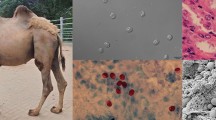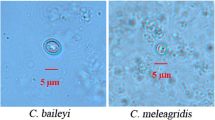Abstract
Cryptosporidium serpentis, a protozoan observed first in snakes, has also been found in lizards and other reptiles. However, there are few reports of the characteristics of C. serpentis isolated from humans and other animals. The present study was undertaken to characterize a C. serpentis isolate from a calf in terms of morphology, host specificity, and small-subunit ribosomal RNA (SSU rRNA) and heat shock protein 70 (HSP 70) gene sequences. Oocysts of the isolate measured 6.32 × 5.18 μm, and they had a length/width shape index of 1.22. A cross-transmission study demonstrated that the isolate was infectious in the stomach of BALB/c mice, but not in New Zealand white rabbits or white leghorn chickens. Sequence and phylogenetic analysis of the SSU rRNA and HSP 70 gene revealed that the isolate was identical to C. serpentis, and it was classified in a monophyletic group of C. serpentis. This study is the first description of the characteristics of a C. serpentis isolate from dairy cattle and may contribute to a better understanding of C. serpentis and investigations of the prevalence of Cryptosporidium in cattle.



Similar content being viewed by others
References
Amer S, Honma H, Ikarashi M, Oishi R, Endo M, Otawa K, Nakai Y (2009) The first detection of Cryptosporidium deer-like genotype in cattle in Japan. Parasitol Res 104:745–752
Ayinmode AB, Olakunle FB, Xiao L (2010) Molecular characterization of Cryptosporidium spp. in native calves in Nigeria. Parasitol Res 107:1019–1021
Azami M, Moghaddam DD, Salehi R, Salehi M (2007) The identification of Cryptosporidium species (protozoa) in Ifsahan, Iran by PCR-RFLP analysis of the 18S rRNA gene. Mol Biol 41:934–939
Chen F, Huang K (2007) Prevalence and phylogenetic analysis of Cryptosporidium in pigs in eastern China. Zoonoses Public Health 54:393–400
Fayer R (2010) Taxonomy and species delimitation in Cryptosporidium. Exp Parasitol 124:90–97
Fayer R, Graczyk TK, Cranfield MR (1995) Multiple heterogenous isolates of Cryptosporidium serpentis from captive snakes are not transmissible to neonatal BALB/c mice (Mus musculus). J Parasitol 81:482–484
Fayer R, Santín M, Trout JM, Greiner E (2006) Prevalence of species and genotypes of Cryptosporidium found in 1-2-year-old dairy cattle in the eastern United States. Vet Parasitol 135:105–112
Fayer R, Santín M, Trout JM (2007) Prevalence of Cryptosporidium species and genotypes in mature dairy cattle on farms in eastern United States compared with younger cattle from the same locations. Vet Parasitol 145:260–266
Fayer R, Santín M, Trout JM (2008) Cryptosporidium ryanae n. sp. (Apicomplexa: Cryptosporidiidae) in cattle (Bos taurus). Vet Parasitol 156:191–198
Feltus DC, Giddings CW, Khaitsa ML, McEvoy JM (2008) High prevalence of Cryptosporidium bovis and the deer-like genotype in calves compared to mature cows in beef cow-calf operations. Vet Parasitol 151:191–195
Johnson DW, Pieniazek NJ, Griffin DW, Misener L, Rose JB (1995) Development of a PCR protocol for sensitive detection of Cryptosporidium oocysts in water samples. Appl Environ Microbiol 61:3849–3855
Karanis P, Eiji T, Palomino L, Boonrod K, Plutzer J, Ongerth J, Igarashi I (2010) First description of Cryptosporidium bovis in Japan and diagnosis and genotyping of Cryptosporidium spp. in diarrheic pre-weaned calves in Hokkaido. Vet Parasitol 169:387–390
Khan SM, Debnath C, Pramanik AK, Xiao L, Nozaki T, Ganguly S (2010) Molecular characterization and assessment of zoonotic transmission of Cryptosporidium from dairy cattle in West Bengal, India. Vet Parasitol 171:41–47
Liu A, Wang R, Li Y, Zhang L, Shu J, Zhang W, Feng Y, Xiao L, Ling H (2009) Prevalence and distribution of Cryptosporidium spp. in dairy cattle in Heilongjiang Province, China. Parasitol Res 105:797–802
Martinez I, Belda Neto FM (2001) Contribution to the laboratory diagnosis of human cryptosporidiosis. Rev Inst Med Trop Sao Paulo 43:79–82
Matsubayashi M, Nagano S, Kita T, Narushima T, Kimata I, Iseki M, Hajiri T, Tani H, Sasai K, Baba E (2008) Genetical survey of novel type of Cryptosporidium andersoni in cattle in Japan. Vet Parasitol 158:44–50
Meireles MV, de Oliveira FP, Teixeira WF, Coelho WM, Mendes LC (2011) Molecular characterization of Cryptosporidium spp. in dairy calves from the state of São Paulo, Brazil. Parasitol Res 109:949–951
Nagano S, Matsubayashi M, Kita T, Narushima T, Kimata I, Iseki M, Hajiri T, Tani H, Sasai K, Baba E (2007) Detection of a mixed infection of a novel Cryptosporidium andersoni and its subgenotype in Japanese cattle. Vet Parasitol 149:213–218
Neira-Otero P, Muñoz-Saldías N, Sanchez-Moreno M, Rosales-Lombardo MJ (2005) Molecular characterization of Cryptosporidium species and genotypes in Chile. Parasitol Res 97(1):63–67
Nuchjangreed C, Boonrod K, Ongerth J, Karanis P (2008) Prevalence and molecular characterization of human and bovine Cryptosporidium isolates in Thailand. Parasitol Res 103:1347–1353
O’Donoghue PJ (1995) Cryptosporidium and cryptosporidiosis in man and animals. Int J Parasitol 25:139–195
Park JH, Guk SM, Han ET, Shin EH, Kim JL, Chai JY (2006) Genotype analysis of Cryptosporidium spp. prevalent in a rural village in Hwasun-gun, Republic of Korea. Korean J Parasitol 44:27–33
Paul S, Chandra D, Ray DD, Tewari AK, Rao JR, Banerjee PS, Baidya S, Raina OK (2008) Prevalence and molecular characterization of bovine Cryptosporidium isolates in India. Vet Parasitol 153:143–146
Paul S, Chandra D, Tewari AK, Banerjee PS, Ray DD, Raina OK, Rao JR (2009) Prevalence of Cryptosporidium andersoni: a molecular epidemiological survey among cattle in India. Vet Parasitol 161:31–35
Plutzer J, Karanis P (2009) Genetic polymorphism in Cryptosporidium species: an update. Vet Parasitol 165:187–199
Scott CA, Smith HV, Mtambo MM, Gibbs HA (1995) An epidemiological study of Cryptosporidium parvum in two herds of adult beef cattle. Vet Parasitol 57:277–288
Suresh P, Rehg JE (1996) Comparative evaluation of several techniques for purification of Cryptosporidium parvum oocysts from rat feces. J Clin Microbiol 34:38–40
Szonyi B, Bordonaro R, Wade SE, Mohammed HO (2010) Seasonal variation in the prevalence and molecular epidemiology of Cryptosporidium infection in dairy cattle in the New York City Watershed. Parasitol Res 107(2):317–325
Upton SJ (1990) Cryptosporidium spp. in lower vertebrates. In: Dubey JP, Speer CA, Fayer R (eds) Cryptosporidiosis in man and animals. CRC Press, Boca Raton, pp 147–1156
Watanabe Y, Yang CH, Ooi HK (2005) Cryptosporidium infection in livestock and first identification of Cryptosporidium parvum genotype in cattle feces in Taiwan. Parasitol Res 97(3):238–241
Xiao L, Ryan UM (2004) Cryptosporidiosis: an update in molecular epidemiology. Curr Opin Infect Dis 17:483–490
Xiao L, Sulaiman IM, Ryan UM, Zhou L, Atwill ER, Tischler ML, Zhang X, Fayer R, Lal AA (2002) Host adaptation and host–parasite co-evolution in Cryptosporidium: implications for taxonomy and public health. Int J Parasitol 32:1773–1785
Xiao L, Ryan UM, Graczyk TK, Limor J, Li L, Kombert M, Junge R, Sulaiman IM, Zhou L, Arrowood MJ, Koudela B, Modrý D, Lal AA (2004a) Genetic diversity of Cryptosporidium spp. in captive reptiles. Appl Environ Microbiol 70:891–899
Xiao L, Lal AA, Jiang J (2004b) Detection and differentiation of Cryptosporidium oocysts in water by PCR-RFLP. Methods Mol Biol 268:163–176
Xiao L, Fayer R, Ryan U, Upton SJ (2004c) Cryptosporidium taxonomy: recent advances and implications for public health. Clin Microbiol Rev 17:72–97
Xiao L, Zhou L, Santin M, Yang W, Fayer R (2007) Distribution of Cryptosporidium parvum subtypes in calves in eastern United States. Parasitol Res 100:701–706
Zhou R, Li G, Xiao S, Xia Y, Guo Y (2007) PCR amplification and sequence analyses of ITS-1 rDNA from Cryptosporidium andersoni in dairy cattle. Parasitol Res 100:1135–1138
Acknowledgments
We are grateful to our laboratory technicians for their assistance with the experimental animals. This study was supported by the Doctor Initial Foundation (no. 630904) and Chinese National Natural Science Foundation (no. 31001093).
Author information
Authors and Affiliations
Corresponding author
Rights and permissions
About this article
Cite this article
Chen, F., Qiu, H. Identification and characterization of a Chinese isolate of Cryptosporidium serpentis from dairy cattle. Parasitol Res 111, 1785–1791 (2012). https://doi.org/10.1007/s00436-012-3024-5
Received:
Accepted:
Published:
Issue Date:
DOI: https://doi.org/10.1007/s00436-012-3024-5




